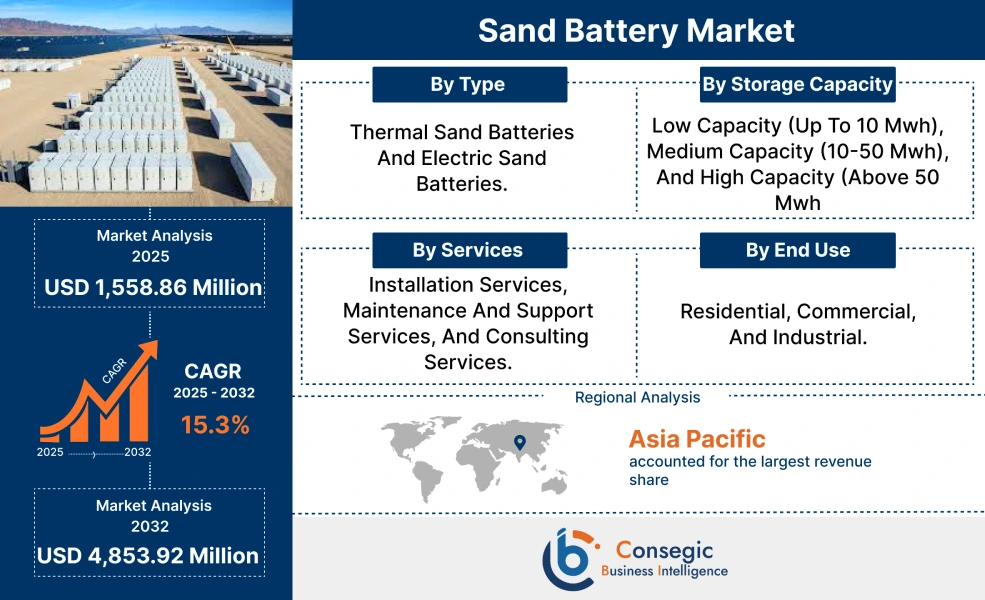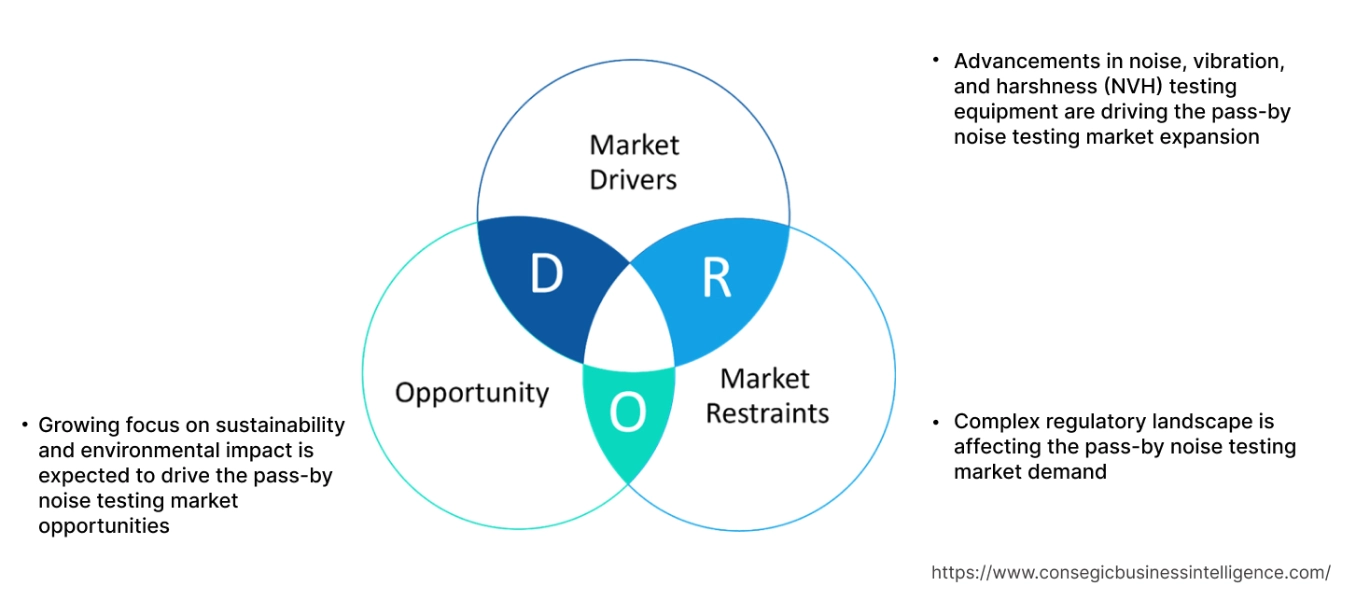Sand Battery Market Size:
Sand Battery Market size is estimated to reach over USD 4,853.92 Million by 2032 from a value of USD 1,348.75 Million in 2024 and is projected to grow by USD 1,558.86 Million in 2025, growing at a CAGR of 15.3% from 2025 to 2032.
Sand Battery Market Scope & Overview:
A sand battery, also known as a thermal energy storage system, stores energy as heat within a large container of sand. It utilizes renewable energy sources to heat the sand, and then that heat can be released later to generate electricity or heat buildings. Sand is heated by renewable energy sources like wind or solar power. This heat is transferred to the sand using a heat transfer fluid or directly through the sand's low-heat conductivity. The heated sand holds the thermal energy for extended periods, potentially months. When energy is needed, the heat from the sand is used to generate steam or hot air, which can then be used for various applications like heating homes, producing electricity, or providing high-temperature process heat for industries.
Sand Battery Market Dynamics - (DRO) :
Key Drivers:
Rising adoption of sand batteries in the residential sector is boosting the market growth
Sand batteries offer a solution for residential energy storage by utilizing sand's ability to store heat. They are particularly useful for storing surplus energy from renewable sources like solar and wind, and then releasing it as heat for heating homes, hot water, or even supplementing district heating systems. They provide a way to store excess renewable energy from sources like solar and wind, ensuring homes can be heated with clean energy.
- For instance, Batsand offers sand battery solutions for the residential sector. The products available in the portfolio include batteries with capacities of 14KW and 25 KW.
Thus, the aforementioned factors are boosting the adoption of sand batteries in turn driving the market growth.
Key Restraints:
Low energy density issues associated with sand batteries are hindering the market growth
Sand has a relatively low energy density as compared to other energy storage methods. This means that large quantities of sand are required to store a significant amount of energy, making the technology impractical for smaller-scale applications.
Moreover, converting stored heat back into electricity is an inefficient process, with losses potentially reaching 50% or more. This significantly reduces the amount of usable energy recovered from the sand battery. Thus, the market analysis shows that the aforementioned factors are restraining the sand battery market demand.
Future Opportunities :
Advancements in material sciences are creating new market opportunities
Material science advancements are crucial for improving the efficiency, scalability, and overall performance of these systems. These advancements focus on enhancing the thermal conductivity and energy density of the sand, as well as improving the efficiency of heat transfer and insulation. Mixing sand with materials like metal chips (e.g., aluminum) increases the overall thermal conductivity of the sand bed. This allows faster and more efficient heat transfer within the battery, leading to improved charging and discharging times. The size and arrangement of sand particles play a significant role in thermal conductivity. Moreover, optimizing these parameters can further enhance heat transfer.
Thus, the advancements in material sciences are projected to drive market opportunities during the forecast period.
Sand Battery Market Segmental Analysis :
By Type:
Based on the type, the market is segmented into thermal sand batteries and electric sand batteries.
Trends in the Type:
- Rising demand for electric sand batteries to address the intermittency of renewable energy and store energy for later use, potentially reducing reliance on fossil fuels.
- Increasing trend in the adoption of thermal sand batteries due to the ability to store large amounts of energy, which potentially lower costs.
The thermal sand batteries segment accounted for the largest revenue share in the market in 2024 and it is also expected to register the fastest CAGR during the forecast period.
- Sand batteries typically involve two tanks of sand, one hot and one cold. A heat transfer fluid circulates between the tanks, transferring heat from the hot tank to the cold tank during charging.
- During discharge, the heat is transferred back, potentially to power a generator or supply heat for other purposes.
- Sand batteries offer several benefits, including the ability to store large amounts of energy, lower costs as compared to lithium-ion batteries, and the potential for long-term storage.
- Thus, the aforementioned factors are boosting the market growth during the forecast period.
By Storage Capacity:
Based on the storage capacity, the market is segmented into low capacity (Up to 10 MWh), medium capacity (10-50 MWh), and high capacity (Above 50 MWh).
Trends in the Storage Capacity:
- Rising adoption of low-capacity sand batteries in the residential sector is boosting the market growth.
- Increasing trend in the adoption of high-capacity sand batteries in the industrial sector to provide heat for industrial applications.
The medium capacity (10-50 MWh) segment accounted for the largest revenue share in the market in 2024 and it is also expected to register the fastest CAGR during the forecast period.
- The medium-capacity sand batteries are used in medium to large-scale projects for district heating, industrial processes, or even power generation.
- Sand batteries store heat from renewable sources and release it to heat buildings and water systems.
- Many industrial processes require high temperatures, and sand batteries provide the necessary heat.
- These batteries store surplus electricity when renewable energy production is high and release it when demand is greater than supply.
- Thus, the aforementioned factors are boosting the market growth during the forecast period.
By Services:
Based on the services, the market is segmented into installation services, maintenance and support services, and consulting services.
Trends in the Services:
- Rising trend in the adoption of consulting services to provide proper guidance and technologies to use in sand batteries.
- Increasing adoption of maintenance and support services to provide regular inception and repairs.
The installation services segment accounted for the largest revenue share of 38.50% in the market in 2024.
- Installation services for sand batteries typically involve site preparation, system assembly, and commissioning to ensure proper functionality.
- Site assessment services include evaluating the location for optimal placement of the sand battery.
- The services also include repairing the ground and building the necessary structure for the sand battery, ensuring proper sand placement and insulation to maintain heat storage.
- Moreover, installation services also include connecting the sand battery to other systems like heat pumps or boilers and verifying that the sand battery is operating correctly.
- Therefore, the aforementioned factors are boosting the market growth.
The maintenance and support services segment is expected to register the fastest CAGR during the forecast period.
- Maintenance and support services for sand batteries are crucial to ensure optimal performance and longevity.
- These services include regular inspections, maintenance of insulation, heat exchange systems, and other sysytems, as well as diagnostics and repairs.
- Periodic checks of the battery's integrity, including insulation, heat pipes, and the sand itself, are essential to prevent leaks, damage, or degradation.
- Regular maintenance of the heat exchange system, which transfers heat into and out of the sand, is necessary for efficient operation and for preventing blockages or leaks.
- Thus, the aforementioned factors are expected to boost the market growth during the forecast period.
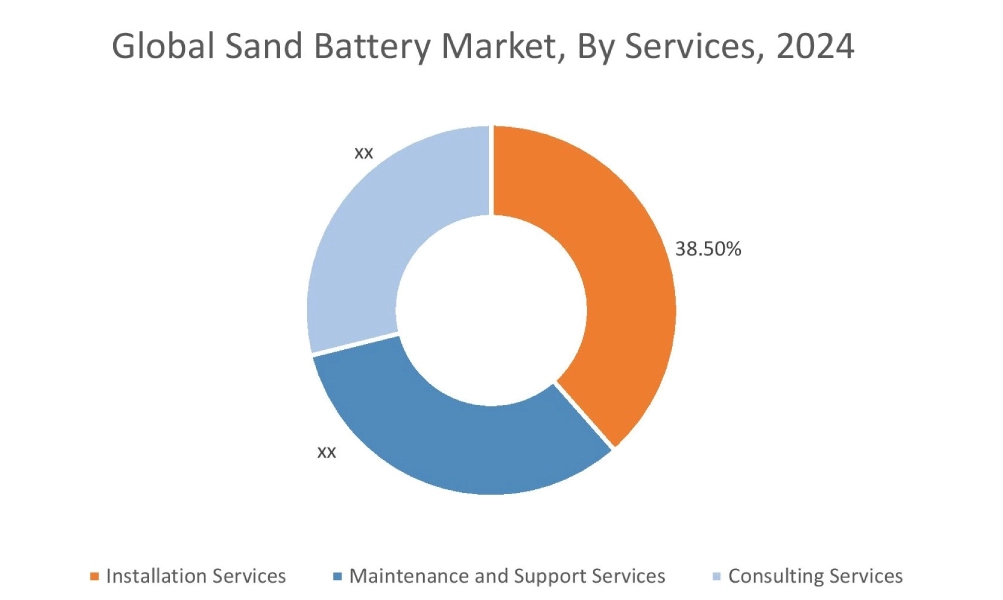
By End User:
Based on the end use, the market is segmented into residential, commercial, and industrial.
Trends in the End Use:
- Rising adoption of sand batteries in the residential sector to provide heat in cold weather is boosting the market growth.
- Increasing trend in the adoption of sand batteries in the industrial sector to provide heat in various industrial applications.
The industrial segment accounted for the largest revenue share in the market in 2024.
- Sand batteries store energy for extended periods, potentially for months, enabling industries to access clean energy even when renewable energy sources are not available.
- Industries like automotive, electronics, and plastics can use sand batteries to provide heat for processes like drying, molding, and curing.
- Moreover, sand batteries provide the high-temperature heat needed for producing glass and ceramics.
- Sand batteries provide the hot water and steam needed for various processes in the food and beverage industry.
- Additionally, sand batteries are used in industrial processes that require heat, such as manufacturing and chemical production.
- Therefore, the aforementioned factors are boosting the market growth.
The commercial segment is expected to register the fastest CAGR during the forecast period.
- Sand batteries store heat from renewable sources (like solar and wind) and release it to heat homes, businesses, and other buildings in district heating networks.
- They help balance the energy supply from intermittent renewable sources like solar and wind, making them more reliable.
- Moreover, sand batteries are integrated into district heating systems, providing clean and efficient heat for commercial buildings.
- Thus, the aforementioned factors are projected to drive the market growth during the forecast period.
Regional Analysis:
The regions covered are North America, Europe, Asia Pacific, the Middle East and Africa, and Latin America.
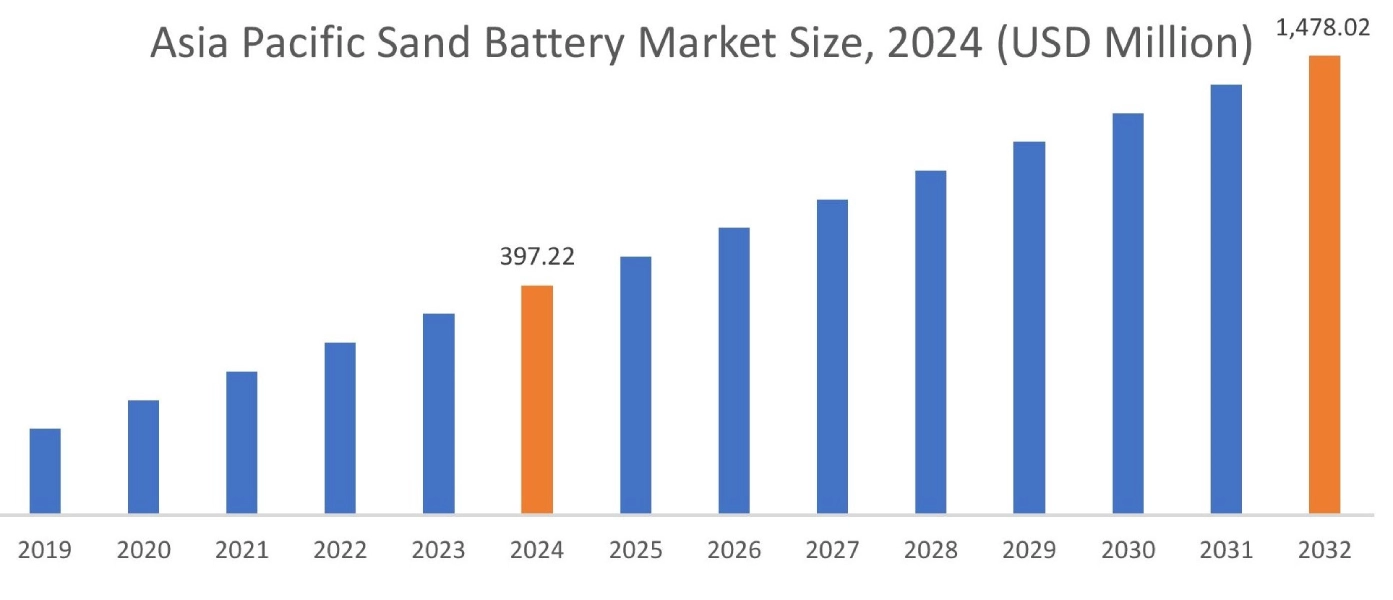
Asia Pacific region was valued at USD 397.22 Million in 2024. Moreover, it is projected to grow by USD 460.40 Million in 2025 and reach over USD 1,478.02 Million by 2032. Out of this, China accounted for the maximum revenue share of 34.50%. The market in the region is growing due to increasing energy needs and advancements in energy storage technologies. Sand batteries offer a potentially eco-friendly and large-scale energy storage solution, making them attractive for countries in the Asia Pacific seeking to integrate renewable energy sources.
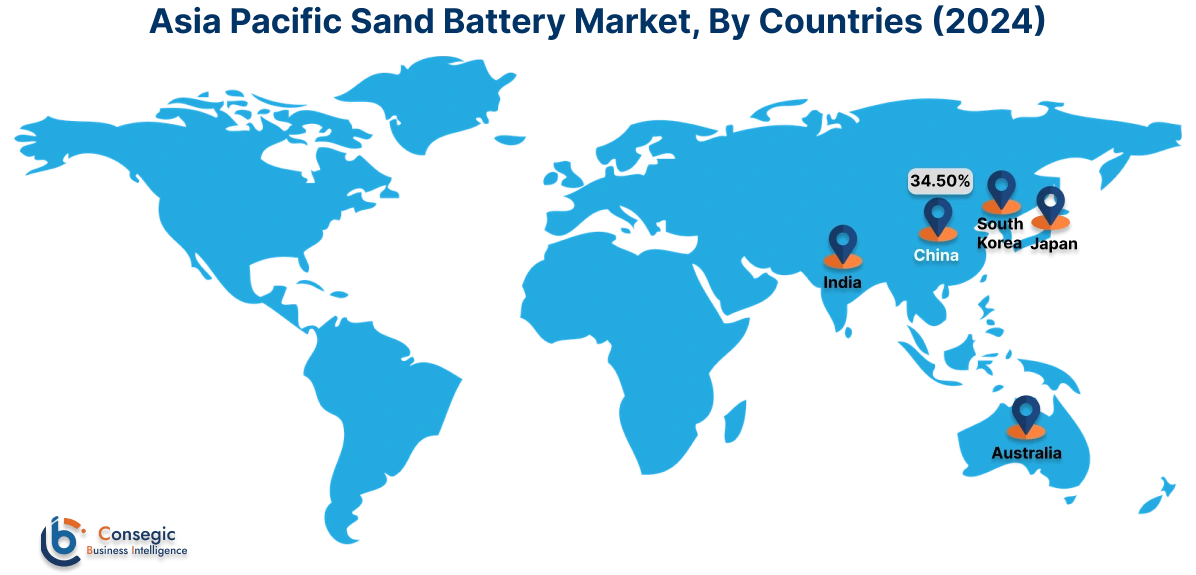
North America is estimated to reach over USD 1,573.16 Million by 2032 from a value of USD 447.39 Million in 2024 and is projected to grow by USD 516.10 Million in 2025. The market in the region is primarily driven by the need to store excess energy from renewable sources like solar and wind and to provide a reliable power supply during peak demand periods.
In Europe, the market is growing due to rising demand for these batteries to store heat, which is further used to provide power or heat for homes and industries. Additionally, in Latin America, the Middle East, and Africa, sand batteries are used to integrate renewable energy sources, reduce reliance on fossil fuels, and provide reliable heat for various applications, in turn boosting the regional market growth.
Top Key Players and Market Share Insights:
The sand battery industry is highly competitive with major players providing solutions and services to the national and international markets. Key players are adopting several strategies in research and development (R&D), product innovation, and end-user launches to hold a strong position in the global sand battery market. Key players in the sand battery industry include -
- Energy Vault (Switzerland)
- Polar Night Energy (Finland)
- Stornetic (Germany)
- Caloric GmbH (Germany)
- Highview Power (UK)
- BrightSource Energy (US)
- ESS Inc. (US)
- EnergyX (US)
- Sila Nanotechnologies (US)
- Heliogen (US)
Sand Battery Market Report Insights :
| Report Attributes | Report Details |
| Study Timeline | 2019-2032 |
| Market Size in 2032 | USD 4,853.92 Million |
| CAGR (2025-2032) | 15.3% |
| By Type |
|
| By Storage Capacity |
|
| By Services |
|
| By End Use |
|
| By Region |
|
| Key Players |
|
| North America | U.S. Canada Mexico |
| Europe | U.K. Germany France Spain Italy Russia Benelux Rest of Europe |
| APAC | China South Korea Japan India Australia ASEAN Rest of Asia-Pacific |
| Middle East and Africa | GCC Turkey South Africa Rest of MEA |
| LATAM | Brazil Argentina Chile Rest of LATAM |
| Report Coverage |
|
Key Questions Answered in the Report
How big is the sand battery market? +
Sand Battery Market size is estimated to reach over USD 4,853.92 Million by 2032 from a value of USD 1,348.75 Million in 2024 and is projected to grow by USD 1,558.86 Million in 2025, growing at a CAGR of 15.3% from 2025 to 2032.
What are the major segments covered in the sand battery market report? +
The segments covered in the report are type, storage capacity, services, end use, and region.
Which region holds the largest revenue share in 2024 in the sand battery market? +
North America holds the largest revenue share in the sand battery market in 2024.
Who are the major key players in the sand battery market? +
The major key players in the market are Energy Vault (Switzerland), Polar Night Energy (Finland), BrightSource Energy (US), ESS Inc. (US), EnergyX (US), Sila Nanotechnologies (US), Heliogen (US), Stornetic (Germany), Caloric GmbH (Germany), and Highview Power (UK).
